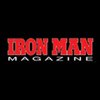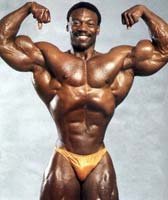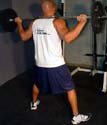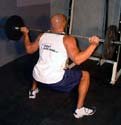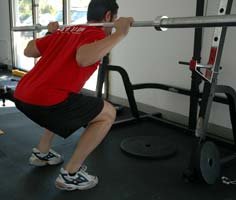Reprinted by permission from IronManMagazine.com.
All bodybuilders - even those who loathe and fear them - admit that squats are the key exercise for developing massive, muscular thighs. Squats, squats and more squats have been the main leg exercise of bodybuilding champions for the past 75 years.
Just about every champ you can name, with the exception of a few rare genetically gifted bodybuilders (Vince Taylor and Paul Dillett come to mind), has devoted many hours to the squat rack.

Build Those Thighs Fast
The reason is simple. The thighs are the body's largest muscles, and they're very powerful. It takes heavy weights to build them up, and squats enable you to use very heavy weights. Squats develop the quadriceps, hamstrings, glutes, and lower back.
They also stimulate growth all over the body, not just in the thighs, because of what's known as an "indirect effect." Arthur Jones, the genius behind the Nautilus machines and training principles, first wrote about it back in the early 1970s in Iron Man Magazine.
As Jones explained, when a muscle grows in response to exercise, it stimulates growth in other muscle groups at the same time. If you train a small muscle like the biceps or the triceps, the thighs, chest and back will experience some indirect growth at the same time, although very small amounts.
The bigger the muscle group, the greater the indirect-growth effect. Since thighs are the largest muscles, training them stimulates the most growth in the rest of the body.
That means you'll never achieve your maximum size in the back, chest and arms unless you develop your thighs to their maximum potential. Even Vince Gironda, the famed Iron Guru and the man who disliked the barbell squat so much he wouldn't even allow squat racks in his gym, believed that "15 percent of upper-body growth comes from intense leg training."
Vince felt that regular barbell squats, at least the way most bodybuilders perform them (head down, lower back rounded over, and glutes coming up first, ahead of the thighs, in a kind of combination good morning/bent-over-squat), overdevelop the glutes, "spread" the hips and widen the waist, which reduces the V-taper.
They also develop the upper thighs too much while not building the lower thighs, creating what he called turnip-shaped thighs. Vince felt that sissy squats, Smith-machine squats done with the feet forward, and hack squats developed more aesthetically pleasing leg shape and mass while minimizing growth in the glutes, hips and waistline.
Not everyone gets a wide waist or wide hips from squatting. Bone structure and other genetic factors play roles as well. Sergio Oliva, Frank Zane, and Brian Buchanan all squatted heavy at different times in their careers but retained amazingly narrow hips, glutes and waistlines because of their gifted genetics.
Sergio Oliva had been a weightlifting champion of Cuba before he defected to the United States. His narrow hips and waistline were actually handicaps when it came to cleaning, pressing, snatching and jerking heavy weights, but they made him a genetic freak in bodybuilding. It just goes to show that a genetic defect in one sport can be a blessing in another.
Bodybuilders from the 1940s and '50s didn't have much choice when it came to exercises for developing their thighs. They didn't have the multitude of leg machines that we have now. They had crude leg extension/leg curl machines, did barbell hack squats and sissy squats and used squat racks for their back and front squats.
For that reason alone you had to squat in order to develop thigh mass and strength in those days; however, many avoided any variation of the exercise because doctors and so-called experts said squats caused knee injuries. They tried to get by with just sissy squats, leg extensions and leg curls and wound up with underdeveloped legs and unsymmetrical physiques.
Then there were the guys who avoided leg training altogether out of sheer laziness. They were the guys who wore long pants at the beach along with the tank tops that showed off their arms and upper body.
By the 1970s, two machines had become pretty common - the vertical leg press and hack squat - and bodybuilders who vehemently disliked barbell squats avoided the squat rack like the plague. Instead, they did leg presses, hack squats, leg extensions, and leg curls in hopes that it would be enough to build the thigh mass and muscularity that the squatters developed.
Nevertheless, most of the big-time champions like Sergio Oliva, Arnold Schwarzenegger and Franco Columbu still did back squats as their main thigh builder.
Then, in the late '70s, Tom Platz arrived on the bodybuilding scene, displaying a kind of thigh mass and thickness and deep separation, even in his lower thighs, that had never been seen before. His main exercise was, of course, the back squat. Tom's leg workouts were legendary for their intensity and sheer all-out effort.
He'd sometimes squat with 405 pounds for 50 reps, and on his so-called light leg day he'd put 225 pounds on the bar and squat for 10 minutes nonstop! When Platz went heavy, he used 600 pounds for 10 reps. That was unheard of in those days.
Some of today's bodybuilders, fueled by a plethora of drugs and supplements, can lift far heavier weights than Platz did in his prime, but he was the pioneer, the man who set the standard for the massive thighs we see on today's champs.
When you get right down to it, with the exception of leg extensions and leg curls, just about every popular leg exercise is a variation of the squat. That includes lunges - a form of one-leg squatting - and leg presses. Some bodybuilders still maintain that squats hurt their knees and lower backs too much.
That's more a problem of proper exercise form and the need to warm-up properly before lifting heavy weights. With the multitude of leg machines available today, there's no reason to avoid leg training. There is no reason to have underdeveloped thighs because you're afraid of injury.
With all the variations of squats available, you can surely find exercises that will enable you to develop your thighs without damaging your knees and lower back.

Squat Variations
Off the top of my head I can list at least a dozen or more kinds of squatting exercises, starting with the standard full barbell squat, a.k.a. the back squat (hamstrings tight against the calves at the bottom).
There are also...
- Parallel Squats
- Half Squats
- One Quarter Squats In The Power Rack
- Squats In The Top Position For A Count Of 10 Seconds In The Power Rack
- Bench Squats
- Front Squats
- Jefferson Squats
- One-Legged Smith-Machine Squats
- Smith-Machine Squats With Your Feet Six To 12 Inches Apart And Forward So There Is No Stress On The Lower Back
- Regular Smith-Machine Squats
- Smith-Machine Front Squats
- Smith-Machine Sumo Squats (Feet Wide Apart And Turned Out To The Sides)
- Roman-Chair Squats
- Barbell Hack Squats
- Machine Hack Squats
- Hack-Machine Front Squats
- Sissy Squats
- Barbell Lunges
- Dumbbell Lunges
- Smith-Machine Lunges
- Leg Presses
- One-Leg Presses
I should add that nearly every one of those exercises can be changed by your using a wide or narrow stance and, on the hack squat and leg press machines, by placing your feet low or high on the foot platform, with your knees in or out.
You can dictate where you develop your thighs - the outer thighs, a.k.a. the sweeps, or the fronts of the quads - by either pushing from your heels or from the balls of your feet as you ascend. Obviously, you can increase training intensity by supersetting two leg exercises or performing drop sets with the help of a training partner.
 |
||
 |
What Are Supersets And Drop Sets? A superset is the alternating back and forth between two (or more) exercises until the prescribed number of sets is complete, usually with no rest between exercises. There are various types of supersets, however. A drop set is a set where you do as many reps as you can with a certain weight, then immediately lower the weight and do more reps. There should be as little rest as possible between sets. Find more definitions in our glossary. |
 |
 |
||
Honestly, it would take a book to give proper coverage to every version of the squat, but here are training tips on the most basic variations to help you develop your thighs without injuring your body.

Training Tips
 Full & Parallel Squats Performed With A Barbell Or Smith
Full & Parallel Squats Performed With A Barbell Or Smith
Machine
These are your number-one mass builders. Unless you're injured or have a serious problem with your knees or lower back, you should always include a version of full or parallel squats in your leg routine. They require more warm-up sets than any other exercise I can think of.
Before squatting heavy, do a couple of light sets of leg extensions to get some blood into your knees and warm-up your legs. Then perform anywhere from two to four warm-up sets of squats, pyramiding up in weight on each successive set.
Remember that these aren't all-out work sets; they're warm-up sets. Pick a weight with which you normally could do 20 reps and do 10. Then choose a weight you could easily use for 15 reps and do an easy seven. And, finally, pick a weight you could squat for 10 reps and do five.
If your knees still feel a bit stiff and sore, do another warm-up set. If they and your legs feel well warmed up, then go ahead and start your work sets. You can squat to parallel (thighs parallel to the floor) or do full squats (hamstrings tight against your calves), depending on your flexibility and preference.
Place the bar across your traps, not high on your shoulders. Your lower back should be arched throughout the squatting motion. Never allow it to round over. Tilt your torso forward about 15 to 20 degrees and lock it in.
Don't lean forward as you descend or lean back as you come up. If you lean forward as you squat, your head goes down and your glutes come up - and you don't want that. It leads to a rocking motion and puts tremendous stress on your lower back. It also causes the load to be placed too much on the glutes and taken off the quads, which is also what you don't want.
Another don't: Don't bounce up from the bottom position, as it's very dangerous for the knees. Try to lock your body into that one tilted-forward position as you squat and come up, staying tight throughout the set. On the way up push up hard from your heels, trying to keep your hips and heels directly under the bar.
For safety reasons, it's best to squat in a power rack, with the safety catches set about where you'd be in the bottom position. That way you don't have to worry about failing on your last reps and getting stuck in the deep-squat position. You can squat till failure and feel secure that the catches are there in case you need to dump the bar.
Even when you're squatting in a power rack, it's still good to have a training partner - who, ideally, is about your size so the safety catches are set right for both of you. A training partner can give you encouragement and help you do a forced rep by pulling up on the bar slightly, enough to get you past the sticking point.
As for Smith Machine squats, some say they are for wimps, but Dorian Yates preferred them to barbell squats, and his thighs were massive beyond belief!
Squatting in the Smith machine allows you to place less stress on your hips, glutes and lower back because you can position your feet forward in front of the machine and then lean back into the bar - with the bar high on your shoulders - making it a very pure thigh exercise (especially if you use a narrow stance - say, with your feet six to 12 inches apart).
The machine's design lends itself to deep, full squats, so take advantage of that. Depending on what part of the thigh you want to develop, push off at the bottom from either your heels, for outer-thigh mass, or the balls of your feet, for middle-thigh development.
Pushing from the heels is best suited to squats done when your feet are shoulder width apart, while pushing from the balls of your feet is best done with your feet six to 12 inches apart.
 Sumo Squats
Sumo Squats
You can do these with a barbell or in a Smith machine. The Smith machine version is a little easier and safer because you don't have to worry about balancing the bar. In either case, take a wide stance - a foot or more outside your shoulders - with your feet turned out to the sides. Sumo squats work the insides of the quads, especially the sartorius muscles.
They also work the "thigh rods" at the tops of the thighs, where they blend into the torso. Not only that, but they hit the hamstrings quite rigorously as well. In fact, along with so-called hamstring leg presses - with your feet high on the platform, heels on the top edge and toes completely off the platform - sumo squats are the best hamstring builders around.
 Barbell Hack Squats
Barbell Hack Squats
Place a barbell behind your body, tucked tightly under your glutes. With a two-to-six-inch block under your heels, squat as low as you can, but come up only two-thirds of the way to keep constant tension on your lower thighs, especially the teardrop muscle above the knee.
This technique is a favorite of thigh master Roger Stewart, who prefer the barbell to the hack squat machine.
 Machine Hack Squats
Machine Hack Squats
Depending on where you place your feet on the platform, you can work more upper or lower thigh, more outer thigh or middle thigh. By placing your feet high and wide on the platform, with your knees wide apart, and pushing from your heels, you can hit mostly outer thighs and sweep.
If you place your feet low on the platform, with your knees in, and push off from the balls of your feet, you work mostly lower thigh. If you place them in the middle of the platform with your knees almost touching and push off from the balls of your feet, you target mostly the middle portion of the quadriceps. If you push from your heels, you'll work mostly outer and upper thighs.
Whether your target is the outer- or lower-thigh area, come up only two-thirds to three-quarters of the way to maintain constant tension on the thighs. Try to go deep in the bottom position to work the muscles over a fuller range of motion.
 Front Squats
Front Squats
This is an excellent lower-thigh and teardrop developer. Take the bar from the squat rack, resting it across your upper chest and delts, with your hands crossed over your chest for balance. Some lifters like to squat with their heels elevated on a two-by-four for better balance.
As with other types of squats, look straight ahead, keep your back arched, and try to come up under the weight as you rise to the top. And don't bounce out of the bottom position. Rather, imagine your body as a coil under tension and use that tension to "explode" up from the bottom position, continuing smoothly to the top.
 Sissy Squats
Sissy Squats
Despite its name, this exercise is not for sissies. Even the most hardcore regular squatter can be whimpering in pain after a proper set of bodyweight sissy squats. To do these right, get up on your toes and lean back until your upper body is almost parallel to the floor.
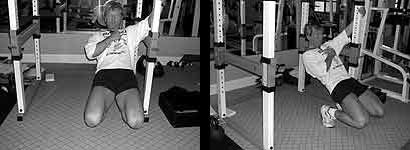
Sissy Squat.
Your quads and torso should be on the same plane - in line. Imagine there's a low bar in front of you and you're trying to limbo under the bar. As you come up, drive your hips and knees forward. Come up only two-thirds of the way to keep constant tension on your quads.
 Half Squats & Bench Squats
Half Squats & Bench Squats
These are great for developing strength and power. They enable you to use very heavy weights and for safety purposes are best done in a power rack.
Still, you should have a training partner spotting you in case you get stuck in the low position. Half squats and bench squats are best done for low to medium reps - say, four to eight.
Some people like to place a low bench between their legs that stops them six to eight inches above parallel. As soon as they feel the bench, they return to the locked-out position. That movement is a good upper-thigh builder but doesn't work the lower thighs, so don't overdo it.
Keep an eye on your development. If your upper thighs start getting out of proportion to your lower thighs (and 90 percent of bodybuilders look that way to begin with), reduce your sets or drop the exercise from your routine.
Do half squats or bench squats after you've done your barbell or Smith machine squats, when your legs and body are well warmed up. On your first set of half or bench squats, you should use the weight you used during your final set of full or parallel squats.
 Quarter Squats
Quarter Squats
This variation won't build much thigh mass, but it'll make you much stronger, so you can use heavier weights on your other heavy leg work - which will result in bigger and more muscular legs. These will enable you to use maximum weights, and you should always do them in a power rack. You should also have a training partner to help you get the bar into position.
Set the safety bars one or two inches below where you'd be in the top position of a squat. On quarter squats, do sets of four to six reps with your maximum full- or parallel-squat poundage plus at least 50 percent more than that. For example, if you squat 200 pounds for six reps: 50 percent of 200 is 100. So for your first set of quarter squats you'd use 300 pounds.
The range of motion is only a few inches. Keep your abs and back tight, and just bend your knees two or three inches. At the top, pause briefly before squatting again. Guard against doing the reps too fast because the tendency is to sort of bounce up and down quickly, and the bar starts twisting.
Do two to three sets of quarter squats, adding weight to the bar on each successive set, as follows: 1x6-8, 1x4-6, 1x4. You'll be amazed at how quickly you gain strength from these. After only a few weeks you'll be using weights you never dreamed possible.
 Squat Static Holds
Squat Static Holds
Like quarter squats, squat static holds also won't build much thigh mass, but they'll make you much stronger, so you can use heavier weights on your other heavy leg work - which will result in bigger and more muscular legs. They'll enable you to use maximum weights, and you should always do them in a power rack. You should also have a training partner to help you get the bar into position.
For these all you do is hold the bar across your traps while standing in the most fully erect position. Start with the weight you used on your final set of quarter squats and add weight on each successive set. Do three sets of 10-second holds, resting two to three minutes between sets.
Don't bend your knees at all except for the first repetition, when you have to bend them a little to pop the bar off the racks. It's best if your training partner helps you with the first rep so you can control the bar.
The weights you use are so heavy in comparison to what your body is accustomed to - expect to use 80 to 100 percent over what you'd use on full or parallel squats - that strength increases will come quickly. And it's kind of fun to see just how much weight you can hold for 10 seconds.
If you really want to push up the intensity, you can try a couple of extra sets on which you reduce the hold time to five seconds and then an absolute maximum effort of one to two seconds. You can also experiment with holding the weights for more than 10 seconds - say 15 to 20 seconds, then 25 to 30. That's after you've been doing the 10-second holds for a month or so.
Just because it's a limited range of motion, or no motion in the case of the static holds, don't think these are easy. On the contrary, the weights are so heavy that the sets will take all your concentration and strength. It's hard stuff - so intense, difficult, and taxing that I suggest you do quarter squats and the static-hold squats just once or twice a month.
Those two exercises make your skeletal frame and the deep, underlying back muscles very strong, along with the spinal erectors, abdominals, hips and thighs. Your whole body gets stronger!
If you normally full-squat 315 pounds for six reps, your strength will shoot up rapidly when you start putting 400 and 500 pounds across your shoulders. After you do several sets of 10-second static holds with 500 pounds, the next time you squat, 315 pounds will feel pretty light. You'll probably get nine or 10 repetitions, maybe even more.

Sample Routines
If your thighs need more size, sweep, muscularity or power, squats can give them to you in spades. Try an all-squat routine for great results. Pick three of the exercises discussed above and perform three to five sets of each, pyramiding up the weight on each successive set.
Here are two sample routines that are bound to improve your thighs.
 Routine A
Routine A
Leg Extensions:
(Warm-Up) 2 sets x 15-20 reps
Smith-Machine Squats:
(Warm-Up) 3 x 20, 10, 6
(Work Sets) 5 x 10, 8, 6, 4, 3-4
Hack Squats:
(Warm-Up) 1 x 15
(Work Sets) 3 x 12, 10, 8(5) - the last set is a drop
Sumo Squats:
(Warm-Up) 1 x 15
(Work Sets) 3 x 12, 10(8)(6), 8(6)(4) - the last two sets are double drops
 Click Here For A Printable Log Of Squat Routine A.
Click Here For A Printable Log Of Squat Routine A.
 Routine B (Power Program)
Routine B (Power Program)
Leg Extensions:
(Warm-Up) 2 x 20
Parallel Squats:
(Warm-Up) 3 x 20, 10, 6
(Work Sets) 5 x 10, 8, 6, 4, 3-4
Bench Squats:
(Start With The Weight Used On Your Last Set Of Parallel Squats) 4 x 8, 6, 4, 3
Optional (In Power Rack) 1
Quarter Squats:
(In Power Rack, Long Pins Set Four Inches Below Lockout; Begin With The Weight Used On Your Last Set Of Bench Squats) 4 x 6-8, 4-6, 3-4, 2-3
Static Holds For 10 Seconds:
(Begin With The Weight Used On Your Last Set Of Quarter Squats And Pyramid The Weight) 3 x 10 seconds
 Click Here For A Printable Log Of Squat Routine B (Power Program).
Click Here For A Printable Log Of Squat Routine B (Power Program).

Conclusion
Keep a training journal of the weights you use and the number of reps you perform on each set of each exercise. Then try to beat what you did at the previous workout each time you train legs.
If your thighs have stopped growing or you're cursed with skinny legs, try the all-squat routines for eight to 10 weeks. If you train with high intensity and increase your poundages regularly, you'll add mass and sweep to your thighs - guaranteed.
Reprinted with permission from Iron Man Magazine.
